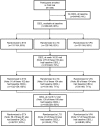Pretreatment behavior and subsequent medication effects in childhood absence epilepsy
- PMID: 28916534
- PMCID: PMC5644466
- DOI: 10.1212/WNL.0000000000004514
Pretreatment behavior and subsequent medication effects in childhood absence epilepsy
Abstract
Objective: To characterize pretreatment behavioral problems and differential effects of initial therapy in children with childhood absence epilepsy (CAE).
Methods: The Child Behavior Checklist (CBCL) was administered at baseline, week 16-20, and month 12 visits of a randomized double-blind trial of ethosuximide, lamotrigine, and valproate. Total problems score was the primary outcome measure.
Results: A total of 382 participants at baseline, 310 participants at the week 16-20 visit, and 168 participants at the month 12 visit had CBCL data. At baseline, 8% (95% confidence interval [CI] 6%-11%) of children with CAE had elevated total problems scores (mean 52.9 ± 10.91). At week 16-20, participants taking valproic acid had significantly higher total problems (51.7 [98.3% CI 48.6-54.7]), externalizing problems (51.4 [98.3% CI 48.5-54.3]), attention problems (57.8 [98.3% CI 55.6-60.0]), and attention-deficit/hyperactivity problems (55.8 [98.3% CI 54.1-57.6]) scores compared to participants taking ethosuximide (46.5 [98.3% CI 43.4-49.6]; 45.8 [98.3% CI 42.9-48.7]; 54.6 [98.3% CI 52.4-56.9]; 53.0 [98.3% CI 51.3-54.8]). Lack of seizure freedom and elevated week 16-20 Conner Continuous Performance Test confidence index were associated with worse total problems scores. At month 12, participants taking valproic acid had significantly higher attention problems scores (57.9 [98.3% CI 55.6-60.3]) compared to participants taking ethosuximide (54.5 [95% CI 52.1-56.9]).
Conclusions: Pretreatment and ongoing behavioral problems exist in CAE. Valproic acid is associated with worse behavioral outcomes than ethosuximide or lamotrigine, further reinforcing ethosuximide as the preferred initial therapy for CAE.
Clinicaltrialsgov identifier: NCT00088452.
Classification of evidence: This study provides Class II evidence that for children with CAE, valproic acid is associated with worse behavioral outcomes than ethosuximide or lamotrigine.
© 2017 American Academy of Neurology.
Figures
Comment in
-
Behavior Problems in Childhood Absence Epilepsy: A Chicken or Egg Problem.Epilepsy Curr. 2018 Mar-Apr;18(2):97-98. doi: 10.5698/1535-7597.18.2.97. Epilepsy Curr. 2018. PMID: 29670485 Free PMC article. No abstract available.
References
-
- Berg AT, Shinnar S, Levy SR, Testa FM, Smith-Rapaport S, Beckerman B. How well can epilepsy syndromes be identified at diagnosis? A reassessment 2 years after initial diagnosis. Epilepsia 2000;41:1269–1275. - PubMed
-
- Jallon P, Loiseau P, Loiseau J. Newly diagnosed unprovoked epileptic seizures: presentation at diagnosis in CAROLE study: Coordination Active du Reseau Observatoire Longitudinal de l' Epilepsie. Epilepsia 2001;42:464–475. - PubMed
-
- Wirrell EC, Camfield CS, Camfield PR, Dooley JM, Gordon KE, Smith B. Long-term psychosocial outcome in typical absence epilepsy: sometimes a wolf in sheeps' clothing. Arch Pediatr Adolesc Med 1997;151:152–158. - PubMed
-
- Austin JK, Harezlak J, Dunn DW, Huster GA, Rose DF, Ambrosius WT. Behavior problems in children before first recognized seizures. Pediatrics 2001;107:115–122. - PubMed
-
- Wilson SJ, Baxendale S. The new approach to classification: rethinking cognition and behavior in epilepsy. Epilepsy Behav 2014;41:307–310. - PubMed
Publication types
MeSH terms
Substances
Associated data
Grants and funding
LinkOut - more resources
Full Text Sources
Other Literature Sources
Medical
Research Materials

